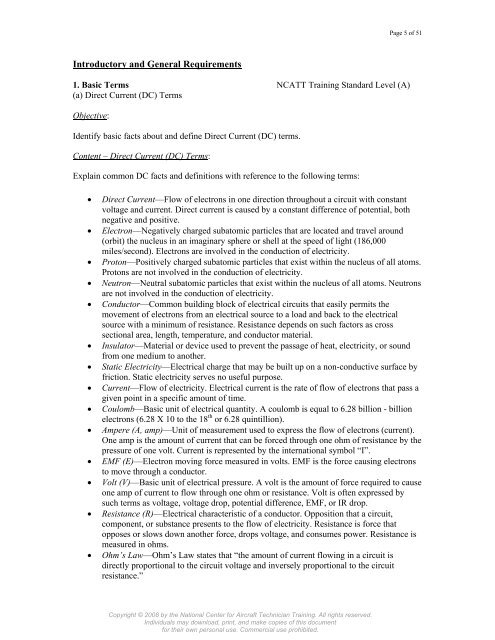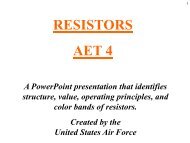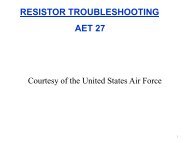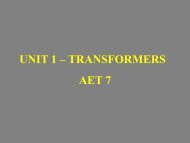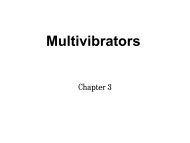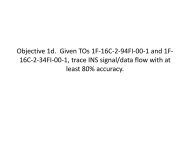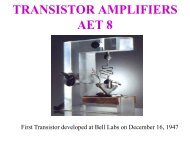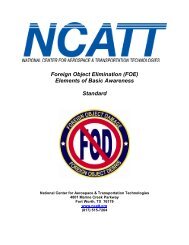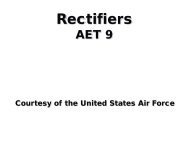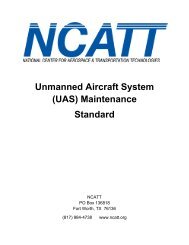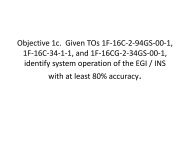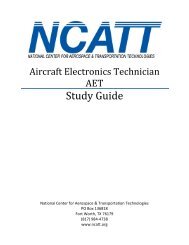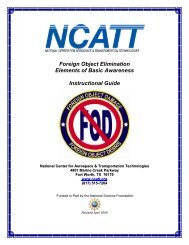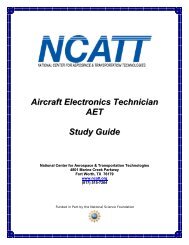(AET) Study Guide - NCATT
(AET) Study Guide - NCATT
(AET) Study Guide - NCATT
- No tags were found...
Create successful ePaper yourself
Turn your PDF publications into a flip-book with our unique Google optimized e-Paper software.
Page 5 of 51Introductory and General Requirements1. Basic Terms <strong>NCATT</strong> Training Standard Level (A)(a) Direct Current (DC) TermsObjective:Identify basic facts about and define Direct Current (DC) terms.Content – Direct Current (DC) Terms:Explain common DC facts and definitions with reference to the following terms:• Direct Current—Flow of electrons in one direction throughout a circuit with constantvoltage and current. Direct current is caused by a constant difference of potential, bothnegative and positive.• Electron—Negatively charged subatomic particles that are located and travel around(orbit) the nucleus in an imaginary sphere or shell at the speed of light (186,000miles/second). Electrons are involved in the conduction of electricity.• Proton—Positively charged subatomic particles that exist within the nucleus of all atoms.Protons are not involved in the conduction of electricity.• Neutron—Neutral subatomic particles that exist within the nucleus of all atoms. Neutronsare not involved in the conduction of electricity.• Conductor—Common building block of electrical circuits that easily permits themovement of electrons from an electrical source to a load and back to the electricalsource with a minimum of resistance. Resistance depends on such factors as crosssectional area, length, temperature, and conductor material.• Insulator—Material or device used to prevent the passage of heat, electricity, or soundfrom one medium to another.• Static Electricity—Electrical charge that may be built up on a non-conductive surface byfriction. Static electricity serves no useful purpose.• Current—Flow of electricity. Electrical current is the rate of flow of electrons that pass agiven point in a specific amount of time.• Coulomb—Basic unit of electrical quantity. A coulomb is equal to 6.28 billion - billionelectrons (6.28 X 10 to the 18 th or 6.28 quintillion).• Ampere (A, amp)—Unit of measurement used to express the flow of electrons (current).One amp is the amount of current that can be forced through one ohm of resistance by thepressure of one volt. Current is represented by the international symbol “I”.• EMF (E)—Electron moving force measured in volts. EMF is the force causing electronsto move through a conductor.• Volt (V)—Basic unit of electrical pressure. A volt is the amount of force required to causeone amp of current to flow through one ohm or resistance. Volt is often expressed bysuch terms as voltage, voltage drop, potential difference, EMF, or IR drop.• Resistance (R)—Electrical characteristic of a conductor. Opposition that a circuit,component, or substance presents to the flow of electricity. Resistance is force thatopposes or slows down another force, drops voltage, and consumes power. Resistance ismeasured in ohms.• Ohm’s Law—Ohm’s Law states that “the amount of current flowing in a circuit isdirectly proportional to the circuit voltage and inversely proportional to the circuitresistance.”Copyright © 2008 by the National Center for Aircraft Technician Training. All rights reserved.Individuals may download, print, and make copies of this documentfor their own personal use. Commercial use prohibited.


